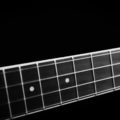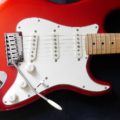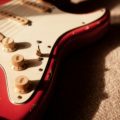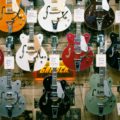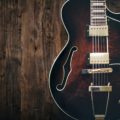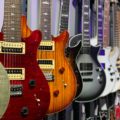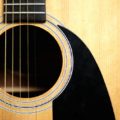Guitar amplifiers are electronic amplifiers designed specifically for use with electronic musical instruments, such as electric guitars.
There are two primary types of guitar amplifiers. The first is the combination (or combo) amplifier, which houses the amplifier head and guitar speakers within a single unit. The amplifier head contains the electronic circuitry for the preamp, integrated effects processing, and power amplifier.
The second type consists of a separate amplifier head and speaker cabinet, connected by wires. The detached amplifier is called an amplifier head, and it is typically placed on top of one or more speaker enclosures. When positioned on a guitar speaker cabinet, it forms an amplifier stack or amp stack.
Types of Instrument Amplifiers
A wide variety of instrument amplifiers can now be used with electric guitars. Some are designed for general-purpose use, while others are tailored for specific instruments or even particular sounds. These include:
- Classic guitar amplifiers produce a clean, warm sound with a sharp treble roll-off at 5 kHz or less and bass roll-off at 60 to 100 Hz. They often have built-in reverb and tremolo (vibrato) units. These amplifiers are commonly used by traditional rock, blues, and country musicians. When played at high volume levels, the sound may become distorted. To counter this, high-end bass amplifiers sometimes include compressor or limiter features and an XLR DI output for direct connection to a mixing Music Production - Improve Your Sound - The rise in popularity of work-from-home studios has significantly impacted the music production landscape in recent years, driven by the increasing availability of tools and technology. This growth has led to the emergence of mobile recording rigs, making it possible to record full band performances anywhere. While one might anticipate a wealth of high-quality music,… board. To keep the bass amplifiers cool, they are often equipped with external metal heat sinks or fans.
- Keyboard amplifiers have a low distortion rate and often include a simple onboard mixer, allowing keyboardists to control the tone and volume of multiple keyboards.
- Acoustic guitar How to Buy a Guitar - The guitar is known for its dynamic and unique sound, making it a popular instrument in various genres of music. Whether you're a beginner or someone with a growing passion for guitar playing, here are some top tips for buying a guitar: Seek out advice. Start by seeking guidance from someone you know who has… amplifiers are designed to produce a clean, transparent acoustic sound when used with acoustic instruments featuring built-in transducer pickups and microphones.
In addition to a 1/4-inch input jack, some instrument amplifiers also have an additional input jack for connecting a microphone. This is easily recognizable as it typically uses a 3-pin XLR connector. Higher-quality amplifiers may also provide phantom power, allowing musicians to use condenser microphones.
Vacuum tube guitar amplifier circuits are relatively simple. Two triodes are used in the preamplifier section to achieve a high signal level for tone control and driving subsequent sections. Two more triodes split the signal phase and drive the final pentode or beam tetrode tubes of the push-pull power amplifier stage.
Solid-state guitar amplifiers generally have the fastest response time, even more so than modeling amps. Tubes tend to create warm overdrive sounds rather than simply cutting off the peaked signal. They gently compress the peaked sound, resulting in a fuzzy overdrive tone.
Modeling guitar amplifiers are used to simulate the sounds of popular cabinets, guitar amps, and effects. This is achieved through digital processing, although there are also analog modeling amps available, such as the Tech 21 Sansamp. Modeling amps typically offer a variety of tones and effects, as well as cabinet simulation, which facilitates recording without the need for a microphone.
Manuel Marino is a seasoned Senior Producer, Music Composer, and Artist with over a decade of experience. He specializes in branded entertainment across various mediums, including video games, films, and advertising campaigns. With 20+ years as a game music composer, Manuel has worked on numerous platforms, creating diverse orchestral soundtracks. HIRE ME


 Manuel is a passionate, driven, and techsavvy AV technician,
Manuel is a passionate, driven, and techsavvy AV technician, 